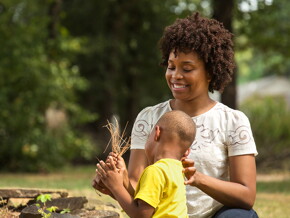
Here are our top 3 fun family games that can be adapted to the age of your child
Treasure hunt
Exactly as you expect, treasure hunt games include taking turns looking for a "treasure". Set the difficulty by the age of your child. This is a great way to teach your child “object permanence”, simply that things still exist even though the child can’t see them. There are many stages of this development, from newborn to 2 years old. Hiding objects is a great way to teach them this!
For a little one, choose a big bright item, like a red ball, and "hide it" somewhere in a single room.
For a preschooler, choose a smaller but still bright object, like a yellow rubber duck. Expand the hunting area and give verbal clues to encourage the search.
You can make it more in depth for an older child. Draw a treasure map, leave clues, and include an outside area.
Don't forget - these are family games! Let your child take a turn hiding the treasure for you to find!
Hop Scotch
Use chalk to draw a series of 8 - 10 numbered squares close together on your driveway, forming a path. Take turns with your child to make it a true family hop scotch game. Watching you wobble will make them giggle. Watching you regain your balance and carry on will encourage them to do the same. Games are great for teaching by example.
For your littler ones, hold their hands and help them "jump", while you count out loud. This is great for their spatial awareness and for introducing the concept of counting.
Preschoolers love jumping and counting. By drawing the squares in a sequence of 1-2-1-2, you encourage co-ordination, and as they get older, jumping between one leg and two. Once they visually recognize numbers, get them to turn around and jump back, counting backwards as well.
There are dozens of variations you can play with older children. Traditionally, the person who begins throws a marker (small stone) into one of the numbered shapes. If it lands in the lines, the goal is to hop, one-legged, into each shape. You put your other foot down only where there are two shapes alongside each other. And you hop over the shape where the marker landed. When you reach the end, you turn around, pick up the marker as you pass it and then hand it to the next player. If the marker doesn't land in the lines of a shape first time around, the next person has a try.
Hide-and-Seek
Every child loves hide-and-seek, from only a few months old, peekaboo using only your hands can cause hours of joy for your baby. As your child grows up, they will continue to love – and benefit developmentally from – this game. As with Treasure Hunting, start small, and expand the area you play in. Take turns with your child to be the hider and the seeker.
Hide-and-Seek also supports the development of object permanence. It enhances your child’s imagination as they try to come up with creative places to hide. It supports the development of problem-solving skills as they look for clues and seek you out. It teaches the social skill of taking turns. When they are little older, it encourages the fun use of counting. Hide-and-seek remains the best family fun game for kids (and parents) of all ages!
Have you tried any of these games with your family? What are your favorite family games?




















